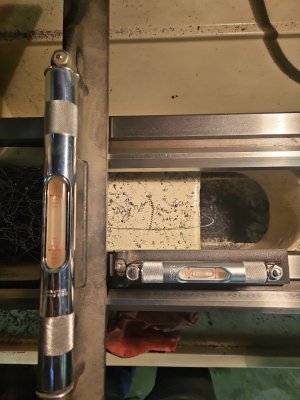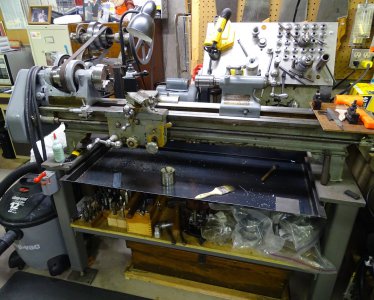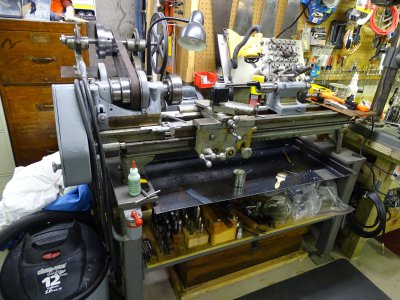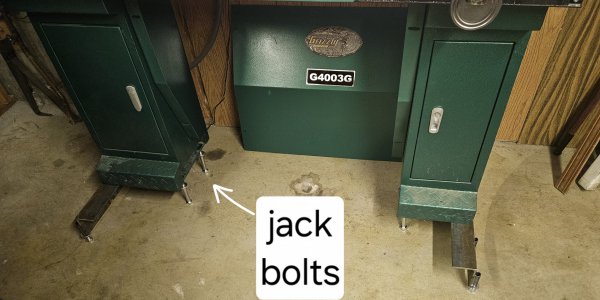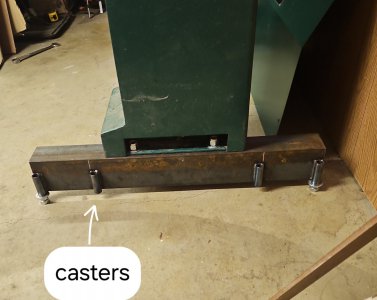So I have been fighting a lot of issues with this lathe so I decided to give it a little bigger footprint. All that weight comes down on a little 8 1/2"x10 1/2" square on either end. I could not get the wiggle out of the lathe so I had to do something. I got the idea from others here on the forum. I had a friend at a local fab shop whip me up some 30" feet. The inner tubes welded on the sides will get caster wheels so when I need to move it when my shop is built I can wheel it to the basement door and into the shop. Also when I need to clean behind it or while I an converting it to 3 phase I can move it around with ease. I have jack bolts for the inner sides of the bases so I can support them as well. I just need to make some pads to go under them. I may order some hockey pucks depending on their dimensions. Granger also has some nice leveling feet so I might go that way also. Anyway, thanks to everyone on this forum for all the great information and the willingness to share it. Have a good weekend.
-
Welcome back Guest! Did you know you can mentor other members here at H-M? If not, please check out our Relaunch of Hobby Machinist Mentoring Program!
You are using an out of date browser. It may not display this or other websites correctly.
You should upgrade or use an alternative browser.
You should upgrade or use an alternative browser.
Put bigger feet on my G4003G
- Thread starter JLDavid
- Start date
I decided on 30 " because that will fit through my basement door. When I don't need the casters I will put leveling feet in the inner tubes as well. Do you guys put something between the feet and concrete floor like hard plastic or rubber?
David
David
- Joined
- Feb 26, 2021
- Messages
- 470
I did a similar thing with my teetering asian 12x36, but it lifted the machine too tall for my 5'-8" liking. I wound up building a stand, in the end.
Regarding leveling casters on a lathe, some around here will frown on the idea (based on past threads). If you used leveling casters for the inside feet, and hard points on the outside, that would serve well, I should think.
Regarding leveling casters on a lathe, some around here will frown on the idea (based on past threads). If you used leveling casters for the inside feet, and hard points on the outside, that would serve well, I should think.
- Joined
- Jun 7, 2013
- Messages
- 10,089
I put a piece of tarpaper under leveling pads, it adheres to the floor and the pads preventing things from moving around with vibration.
I am one of those persons and a journeyman machinist and shop owner that severely frowns on casters under machinery, (just saying)
I am one of those persons and a journeyman machinist and shop owner that severely frowns on casters under machinery, (just saying)
Thanks for the info. The casters will only be put on when I need to move the lathe. When it is set in position where is will live it will be on leveling feet always. Probably 4 on the outside of each foot and on the cabinets in the middle. I probably didn't say that right in my origional post. My bad.
- Joined
- Apr 14, 2014
- Messages
- 3,152
I used 4" x 6" x 3/8" thick plates under the leveling screws on both my Sheldon and Seneca Falls lathes. The leveling screws are 1" in diameter. The additional length and width keeps the screws from digging into or sliding on the concrete. In the center of each plate is a divot made by a 1" ball end mill. The divot keeps the leveling screw centered.
Here's a picture of the plates under the Seneca Falls machine. The ones under the Sheldon are hidden by the base cabinet.
Here's a picture of the plates under the Seneca Falls machine. The ones under the Sheldon are hidden by the base cabinet.
Attachments
So as I read through this forum I find out that I can't level my lathe across the Vs on the ways. Not sure why Grizzly would not make them the same height but I ordered 2 1"x1" guage blocks use on the flats. I do understand the difference between leveling vs making the machine parallel to the chuck. My thought is to start it out level and see where I have to go from there to do the 2 collar test. Still a little confused on the 2 collar test but that will give me something to study up on between football games.
- Joined
- Jun 10, 2019
- Messages
- 534
I've been debating to do similar (as far as make my own base vs. modifying the cabinets). Did you intentionally keep the 2 sets of legs somewhat floating to allow the leveling feet to more easily impart twist adjustment to the lathe bed? Or would it not matter much?Here's a picture of the plates under the Seneca Falls machine. The ones under the Sheldon are hidden by the base cabinet.
When I figured out what I was going to do I thought that leveling feet out on the ends of the legs would give me the most adjustment with the least travel of the jack bolts. I still plan to put jack bolts on the inner side of the cabinets when I get some spacers built/found. As far as the extra mounts on the extended feet my plan is to put leveling feet in them as well when they get back in stock at Grangers. When I need to move it I will put the casters in those holes.





